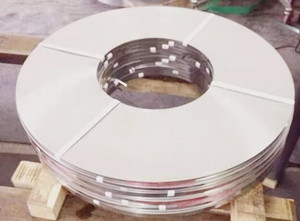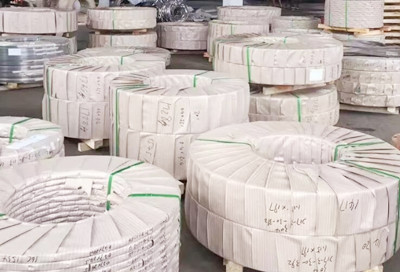- SITEMAP
- CONTACT US
- 8618267732328
News
Credibility ,the lifeblood of enterprise!
- Fittings
- Butt Welding Fittings
- Forged Fittings
- 180 Degree Elbows
- 90 Degree Elbows
- 60 Degree Elbows
- 45 Degree Elbows
- 30 Degree Elbows
- Equal Tee
- Reducing Tee
- Concentric Reducer
- Eccentric Reducer
- Lap Joint Stub End
- Outlets
- Cap
- Bend
- Cross
- Coupling
- Stainless Steel Lateral Tee
- Bellows Expansion Joints
- Flexible Metal Hose
- Non-Standard/Custom Fittings
- Bleed & Flushing Rings
- Types of Flanges
- Anchor Flanges
- Blind Flanges
- Expander Flanges
- High Hub Flanges
- Lap Joint Flanges
- Long Weld Neck Flanges
- Nipoflanges
- Orifice Flanges
- Plate Flanges
- Ring Type Joint Flanges
- Reducing Flanges
- Slip On Flanges
- Socket Weld Flanges
- Spectacle Blind Flanges
- Square Flanges
- Spades & Ring Spacers
- Threaded Flanges
- Welding Neck Flanges
What is stainless steel strip
What is stainless steel strip?
Stainless steel strip can be regarded as the extension product of ultra-thin stainless steel plate. It is a kind of long and narrow stainless steel plate which is usually manufactured to meet the needs of various industrial mechanical products. Stainless steel strip is also called stainless steel strip. The maximum width of stainless steel strip can not exceed 1220 mm, but the length is not limited. According to the processing method, the stainless steel strip can be divided into cold-rolled stainless steel strip and hot-rolled stainless steel strip.
Stainless steel strip has excellent strength, precision, surface finish and other properties, which is widely used in aerospace, petrochemical, automobile, textile, electronics, household appliances, computer and precision machining and other pillar industries.

Classification of stainless steel strip
Stainless steel sheet supplied in coils can also be called strip steel. Divided into hot rolling, cold rolling, ordinary stainless steel strip, high quality stainless steel strip and precision stainless steel strip.
There are many kinds of stainless steel belts, including 201 stainless steel belt, 202 stainless steel belt, 304 stainless steel belt, 301 stainless steel belt, 302 stainless steel belt, 303 stainless steel belt, 316 stainless steel belt, J4 stainless steel belt, 309S stainless steel belt, 316L stainless steel belt, 317L stainless steel belt, 310S stainless steel belt, 430 stainless steel iron belt, etc.
The thickness is 0.02mm-4mm, and the width is 3.5mm-1550mm.
Stainless steel with domestic (imported) stainless steel strip: stainless steel coil strip, stainless steel spring band, stainless steel stamping band, stainless steel precision belt, stainless steel mirror belt, stainless steel cold rolling strip, stainless steel hot rolling strip, stainless steel etching strip, stainless steel stretching belt, stainless steel polishing belt, stainless steel soft belt, stainless steel hard belt, stainless steel medium hard belt, stainless steel high temperature resistant belt, etc.

Cold rolled stainless steel strip

Stainless steel strip or coil is used as raw material and rolled by cold rolling mill at room temperature. The conventional thickness is 0.1 mm ~ 3 mm, while the width is 100 mm ~ 2 000 mm.
Cold rolled stainless steel strip has the advantages of smooth surface, smooth surface, high dimensional accuracy and good mechanical properties. Most products are rolled and can be processed into coated steel plate.
The production process sequence of cold-rolled stainless steel strip or coil is acid pickling, normal temperature rolling, process lubrication, annealing, leveling, fine cutting and packaging.
Stainless steel hot rolled strip

Hot rolled stainless steel strip is made by hot rolling mill with thickness of 1.80mm-6.00mm and width of 50mm-1200mm. Hot rolled stainless steel has the advantages of low hardness, easy processing and good ductility. Its production processes are acid pickling, high temperature rolling, process lubrication, annealing, leveling, fine cutting and packaging.
Difference between cold and hot rolled stainless steel strip
There are three main differences between cold-rolled stainless steel strip and hot-rolled stainless steel strip
- Firstly, the strength and yield strength of cold-rolled stainless steel strip are better, and the ductility and toughness of hot-rolled stainless steel strip are good.
- Secondly, the thickness of cold-rolled stainless steel strip is ultra-thin, while the thickness of hot-rolled stainless steel strip is larger.
- In addition, the surface quality, appearance and dimensional accuracy of cold-rolled stainless steel strip are better than those of hot-rolled stainless steel strip.
Properties of stainless steel strip
Like other materials, the physical properties of stainless steel strip mainly include the following three aspects: melting point, specific heat capacity, thermal conductivity and linear expansion coefficient, electromagnetic properties such as resistivity, conductivity and permeability, and mechanical properties such as young's modulus of elasticity and rigidity coefficient. These properties are generally considered to be inherent characteristics of stainless steel materials, but they are also affected by such factors as temperature, processing degree and magnetic field strength. In general, the thermal conductivity and electrical resistance of stainless steel are lower than that of pure iron.
Correlation between physical properties and temperature
(1) Specific heat capacity
With the change of temperature, the specific heat capacity will change, but in the process of temperature change, once the phase transformation or precipitation occurs in the metal structure, the specific heat capacity will change significantly.
(2) Thermal conductivity
Below 600 ℃, the thermal conductivity of all kinds of stainless steel is in the range of 10 ~ 30W / (m · ℃), and the thermal conductivity increases with the increase of temperature. At 100 ℃, the order of thermal conductivity of stainless steel is 1Cr17, 00Cr12, 2Cr25N, 0cr18ni11ti, 0Cr18Ni9, 0cr17ni12m ο 2 and 2cr25ni20. At 500 ℃, the order of thermal conductivity is 1 CR 13, 1 CR 17, 2 CR 25 n, 0 CR 17 Ni 12 m o 9 2, 0 CR 18 Ni 9 Ti and 2 CR 25 Ni 20. Compared with ordinary carbon steel, the thermal conductivity of austenitic stainless steel is about 1 / 4 of that at 100 ℃.
(3) Coefficient of linear expansion
In the range of 100-900 ℃, the linear expansion coefficients of the main stainless steel grades are basically in the range of 10 ˉ 6 ˉ 6 ˉ 1 ˉ 130 * 10 ˉ 6 ˉ 1, and it increases with the increase of temperature. For precipitation hardening stainless steel, the linear expansion coefficient is determined by aging treatment temperature.
(4) Resistivity
At 0 ~ 900 ℃, the specific resistance of the main grades of stainless steel is 70 * 10 ˉ 6 ~ 130 * 10 ˉ 6 Ω· m, and it increases with the increase of temperature. When it is used as heating material, the material with low resistivity should be selected.
(5) Permeability
Austenitic stainless steel is also known as non-magnetic material because of its low permeability. Steel with stable austenite structure, such as 0 CR 20 Ni 10, 0 CR 25 Ni 20, etc., will not be magnetic even if it is processed with large deformation more than 80%. In addition, austenite stainless steels with high carbon, high nitrogen and high manganese, such as 1cr17mn6nisn, 1Cr18Mn8Ni5N and high manganese austenitic stainless steels, will undergo phase transformation under large reduction, so it remains non-magnetic. At high temperatures above the Curie point, even strong magnetic materials lose their magnetism. However, some austenitic stainless steels, such as 1cr17ni7 and 0Cr18Ni9, have metastable austenite structure, so martensitic transformation will occur during large reduction or low temperature processing, which will have magnetic properties and increase permeability.
(6) Elastic modulus
At room temperature, the longitudinal elastic modulus of ferritic stainless steel is 200kn / mm2, and that of austenitic stainless steel is 193kn / mm2, which is slightly lower than that of carbon structural steel. With the increase of temperature, the longitudinal elastic modulus decreases, the Poisson's ratio increases, and the transverse elastic modulus (rigidity) decreases significantly. The longitudinal elastic modulus will affect the work hardening and microstructure aggregation.
(7) Density
The density of ferritic stainless steel with high chromium content is small, while that of austenitic stainless steel with high nickel and manganese content is high, and the density becomes smaller due to the increase of spacing between the elements at high temperature.
Physical properties at low temperature
(1) Thermal conductivity
The thermal conductivity of all kinds of stainless steel is slightly different at very low temperature, but generally speaking, it is about 1 / 50 of that at room temperature. At low temperature, the thermal conductivity increases with the increase of magnetic flux (flux density).
(2) Specific heat capacity
At very low temperatures, the specific heat capacities of various stainless steels are different. The specific heat capacity is greatly affected by temperature. The specific heat capacity at 4K can be reduced to less than 1 / 100 of the specific heat capacity at room temperature.
(3) Thermal expansion
For austenitic stainless steel, there is a little difference in shrinkage rate (relative to 273k) below 80K. The content of nickel has a certain effect on the shrinkage.
(4) Resistivity
At very low temperature, the difference of resistivity between different grades increases. The alloy elements have great influence on the resistivity.
(5) Magnetism
At low temperature, the effect of mass susceptibility on load magnetic field of austenitic stainless steel is different with different materials. The contents of different alloying elements are also different.
There is no difference in permeability between different grades.
(6) Elastic modulus
At low temperature, the Poisson's ratio of austenitic stainless steel with magnetic transformation has an extreme value.
Source: China Stainless Steel Strip Manufacturer – Yaang Pipe Industry Co., Limited (www.yaang.com)

Tel No:+86-18267732328 / Email:[email protected]
Address:Longwan District, Wenzhou, Zhejiang Province, China.
Copyright Notice © www.yaang.com Yaang Pipe Industry Co., Limited All rights reserved.
Yaang Pipe Industry Co., Ltd. is an international supplier of piping solutions for flange, butt welding fittings, socket welding fittings and threaded fittings. Our products are widely used in different industrial fields, including oil and gas, chemical industry, petrochemical industry, power plant, pulp and paper industry, environmental and water conservancy engineering, engineering projects, etc.





